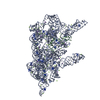[English] 日本語
 Yorodumi
Yorodumi- EMDB-9106: Structure of a group II intron retroelement after DNA integration -
+ Open data
Open data
- Basic information
Basic information
| Entry | Database: EMDB / ID: EMD-9106 | |||||||||||||||
|---|---|---|---|---|---|---|---|---|---|---|---|---|---|---|---|---|
| Title | Structure of a group II intron retroelement after DNA integration | |||||||||||||||
 Map data Map data | group II intron retroelement | |||||||||||||||
 Sample Sample |
| |||||||||||||||
 Keywords Keywords | group II intron / retroelement / retrotransposition / RNA-DNA-RNA Binding Protein complex | |||||||||||||||
| Function / homology |  Function and homology information Function and homology informationRNA-directed DNA polymerase activity / endonuclease activity / nucleic acid binding / zinc ion binding Similarity search - Function | |||||||||||||||
| Biological species |   Thermosynechococcus elongatus (bacteria) / Thermosynechococcus elongatus (bacteria) /   Thermosynechococcus elongatus (strain BP-1) (bacteria) Thermosynechococcus elongatus (strain BP-1) (bacteria) | |||||||||||||||
| Method | single particle reconstruction / cryo EM / Resolution: 3.6 Å | |||||||||||||||
 Authors Authors | Haack D / Yan X | |||||||||||||||
| Funding support |  United States, 4 items United States, 4 items
| |||||||||||||||
 Citation Citation |  Journal: Cell / Year: 2019 Journal: Cell / Year: 2019Title: Cryo-EM Structures of a Group II Intron Reverse Splicing into DNA. Authors: Daniel B Haack / Xiaodong Yan / Cheng Zhang / Jason Hingey / Dmitry Lyumkis / Timothy S Baker / Navtej Toor /  Abstract: Group II introns are a class of retroelements that invade DNA through a copy-and-paste mechanism known as retrotransposition. Their coordinated activities occur within a complex that includes a ...Group II introns are a class of retroelements that invade DNA through a copy-and-paste mechanism known as retrotransposition. Their coordinated activities occur within a complex that includes a maturase protein, which promotes splicing through an unknown mechanism. The mechanism of splice site exchange within the RNA active site during catalysis also remains unclear. We determined two cryo-EM structures at 3.6-Å resolution of a group II intron reverse splicing into DNA. These structures reveal that the branch-site domain VI helix swings 90°, enabling substrate exchange during DNA integration. The maturase assists catalysis through a transient RNA-protein contact with domain VI that positions the branch-site adenosine for lariat formation during forward splicing. These findings provide the first direct evidence of the role the maturase plays during group II intron catalysis. The domain VI dynamics closely parallel spliceosomal branch-site helix movement and provide strong evidence for a retroelement origin of the spliceosome. | |||||||||||||||
| History |
|
- Structure visualization
Structure visualization
| Movie |
 Movie viewer Movie viewer |
|---|---|
| Structure viewer | EM map:  SurfView SurfView Molmil Molmil Jmol/JSmol Jmol/JSmol |
| Supplemental images |
- Downloads & links
Downloads & links
-EMDB archive
| Map data |  emd_9106.map.gz emd_9106.map.gz | 14.5 MB |  EMDB map data format EMDB map data format | |
|---|---|---|---|---|
| Header (meta data) |  emd-9106-v30.xml emd-9106-v30.xml emd-9106.xml emd-9106.xml | 15.3 KB 15.3 KB | Display Display |  EMDB header EMDB header |
| FSC (resolution estimation) |  emd_9106_fsc.xml emd_9106_fsc.xml | 14.3 KB | Display |  FSC data file FSC data file |
| Images |  emd_9106.png emd_9106.png | 149.6 KB | ||
| Filedesc metadata |  emd-9106.cif.gz emd-9106.cif.gz | 6.5 KB | ||
| Archive directory |  http://ftp.pdbj.org/pub/emdb/structures/EMD-9106 http://ftp.pdbj.org/pub/emdb/structures/EMD-9106 ftp://ftp.pdbj.org/pub/emdb/structures/EMD-9106 ftp://ftp.pdbj.org/pub/emdb/structures/EMD-9106 | HTTPS FTP |
-Validation report
| Summary document |  emd_9106_validation.pdf.gz emd_9106_validation.pdf.gz | 387.7 KB | Display |  EMDB validaton report EMDB validaton report |
|---|---|---|---|---|
| Full document |  emd_9106_full_validation.pdf.gz emd_9106_full_validation.pdf.gz | 387.3 KB | Display | |
| Data in XML |  emd_9106_validation.xml.gz emd_9106_validation.xml.gz | 13.9 KB | Display | |
| Data in CIF |  emd_9106_validation.cif.gz emd_9106_validation.cif.gz | 18.8 KB | Display | |
| Arichive directory |  https://ftp.pdbj.org/pub/emdb/validation_reports/EMD-9106 https://ftp.pdbj.org/pub/emdb/validation_reports/EMD-9106 ftp://ftp.pdbj.org/pub/emdb/validation_reports/EMD-9106 ftp://ftp.pdbj.org/pub/emdb/validation_reports/EMD-9106 | HTTPS FTP |
-Related structure data
| Related structure data |  6mecMC  9105C  6me0C M: atomic model generated by this map C: citing same article ( |
|---|---|
| Similar structure data |
- Links
Links
| EMDB pages |  EMDB (EBI/PDBe) / EMDB (EBI/PDBe) /  EMDataResource EMDataResource |
|---|---|
| Related items in Molecule of the Month |
- Map
Map
| File |  Download / File: emd_9106.map.gz / Format: CCP4 / Size: 244.1 MB / Type: IMAGE STORED AS FLOATING POINT NUMBER (4 BYTES) Download / File: emd_9106.map.gz / Format: CCP4 / Size: 244.1 MB / Type: IMAGE STORED AS FLOATING POINT NUMBER (4 BYTES) | ||||||||||||||||||||||||||||||||||||||||||||||||||||||||||||
|---|---|---|---|---|---|---|---|---|---|---|---|---|---|---|---|---|---|---|---|---|---|---|---|---|---|---|---|---|---|---|---|---|---|---|---|---|---|---|---|---|---|---|---|---|---|---|---|---|---|---|---|---|---|---|---|---|---|---|---|---|---|
| Annotation | group II intron retroelement | ||||||||||||||||||||||||||||||||||||||||||||||||||||||||||||
| Projections & slices | Image control
Images are generated by Spider. | ||||||||||||||||||||||||||||||||||||||||||||||||||||||||||||
| Voxel size | X=Y=Z: 0.79 Å | ||||||||||||||||||||||||||||||||||||||||||||||||||||||||||||
| Density |
| ||||||||||||||||||||||||||||||||||||||||||||||||||||||||||||
| Symmetry | Space group: 1 | ||||||||||||||||||||||||||||||||||||||||||||||||||||||||||||
| Details | EMDB XML:
CCP4 map header:
| ||||||||||||||||||||||||||||||||||||||||||||||||||||||||||||
-Supplemental data
- Sample components
Sample components
-Entire : T.el4h group II intron retroelement
| Entire | Name: T.el4h group II intron retroelement |
|---|---|
| Components |
|
-Supramolecule #1: T.el4h group II intron retroelement
| Supramolecule | Name: T.el4h group II intron retroelement / type: complex / ID: 1 / Parent: 0 / Macromolecule list: #1-#3 |
|---|---|
| Source (natural) | Organism:   Thermosynechococcus elongatus (bacteria) Thermosynechococcus elongatus (bacteria) |
-Macromolecule #1: T.el4h RNA
| Macromolecule | Name: T.el4h RNA / type: other / ID: 1 / Number of copies: 1 Classification: polydeoxyribonucleotide/polyribonucleotide hybrid |
|---|---|
| Source (natural) | Organism:   Thermosynechococcus elongatus (bacteria) Thermosynechococcus elongatus (bacteria) |
| Molecular weight | Theoretical: 280.854031 KDa |
| Sequence | String: UUGCGACGCG AAAGCUAGCC AGAUGAUUGU CCCACUAGCC CAACAAGCUA GAACGGGACC GGUUGUUCCC CCAACCGUAG CCUAGGGAG GCAUGCGUGA CUGGUAACGG UCAGGUGUGA AGCCCUCCCG ACAAUGUAGC CCGAACCGCA AGGUUGAAGC U GAAUCCGU ...String: UUGCGACGCG AAAGCUAGCC AGAUGAUUGU CCCACUAGCC CAACAAGCUA GAACGGGACC GGUUGUUCCC CCAACCGUAG CCUAGGGAG GCAUGCGUGA CUGGUAACGG UCAGGUGUGA AGCCCUCCCG ACAAUGUAGC CCGAACCGCA AGGUUGAAGC U GAAUCCGU GAGGAGGAAG CAACUUCACC AGUGUCAGGU GAUAGGGAAC UAGGCUUGAG GGUAUGGUGA GCACAUGCGA AG UGAUGUC AGAAGCCUCG UCACAGACCA ACAGGCCAAA GACACUGAUA GGCCUGAGCC AAAACGGCAA AUGGAUAGGC UAC AUCGCU CGCUCGUCGG UGUACGGGGA CGUCAAUCCA UCGGGGCACA GUCACCACCU AACCCCUCGU GUCAUCUGGU UGGA ACGCG GUAAGCCCGU AUCCUCGCCU UGAACACUCA AGGCAGGCAA ACCGUAAGGA AUGCUGAUGG GGGUGCGGGU AUGGG AUGC AGGAGAAAGC GAAUGCCGGU CUGUAAUGGA CCGGAUAGGG GUUGAGGAGA CAAUCCAACA UCACCCCGCC CGAAAG GGA GCAGACUUCC UGCUGGUCUC UCUUUGCGAG AUAGCCUGUA GAACCUCUUG AAUGGAGACA AGGCAAAUGG CAGUGGA AC AAACCACUGG UGCGGUCACC AACCAAACGG AAACAAGCUG GCACAGCAUA GACUGGGCCA AAGCCAACCG UGAGGUAA A GAGGCUGCAA GUGCGUAUCG CAAAGGCGUU CGCGCCGGUU CCUCUUGAAA GAGGGGCUUU GAGAGGCCUG AGCCGGAUG UGGGGAAACU CACAAGUCCG GUUCUUAGGG GGCGGGGAUG GCAGUAAUGC CUCCCUGCUA CCCGGCG |
| Recombinant expression | Organism:  |
-Macromolecule #2: Sense Target DNA
| Macromolecule | Name: Sense Target DNA / type: dna / ID: 2 / Number of copies: 1 / Classification: DNA |
|---|---|
| Source (natural) | Organism:   Thermosynechococcus elongatus (bacteria) Thermosynechococcus elongatus (bacteria) |
| Molecular weight | Theoretical: 14.032991 KDa |
| Sequence | String: (DG)(DA)(DT)(DA)(DG)(DA)(DG)(DA)(DT)(DT) (DT)(DT)(DC)(DC)(DC)(DA)(DG)(DG)(DG)(DT) (DT)(DG)(DG)(DC)(DC)(DG)(DA)(DG)(DC) (DG)(DG)(DA)(DT)(DG)(DA)(DG)(DG)(DC)(DA) (DG) (DC)(DG)(DA)(DA)(DC) |
-Macromolecule #3: Maturase reverse transcriptase
| Macromolecule | Name: Maturase reverse transcriptase / type: protein_or_peptide / ID: 3 / Number of copies: 1 / Enantiomer: LEVO |
|---|---|
| Source (natural) | Organism:   Thermosynechococcus elongatus (strain BP-1) (bacteria) Thermosynechococcus elongatus (strain BP-1) (bacteria)Strain: BP-1 |
| Molecular weight | Theoretical: 65.065121 KDa |
| Recombinant expression | Organism:  |
| Sequence | String: METRQMAVEQ TTGAVTNQTE TSWHSIDWAK ANREVKRLQV RIAKAVKEGR WGKVKALQWL LTHSFYGKAL AVKRVTDNSG SKTPGVDGI TWSTQEQKAQ AIKSLRRRGY KPQPLRRVYI PKASGKQRPL GIPTTKDRAM QALYALALEP VAETTADRNS Y GFRQGRCT ...String: METRQMAVEQ TTGAVTNQTE TSWHSIDWAK ANREVKRLQV RIAKAVKEGR WGKVKALQWL LTHSFYGKAL AVKRVTDNSG SKTPGVDGI TWSTQEQKAQ AIKSLRRRGY KPQPLRRVYI PKASGKQRPL GIPTTKDRAM QALYALALEP VAETTADRNS Y GFRQGRCT ADAAGQCFTV LGRSDCAKYI LDADITGCFD NISHEWLLDN IPLDKEVLRK WLKSGFVWKQ QLFPTHAGTP QG GVISPML ANMTLDGMEE LLKKHLRKQK VNLIRYADDF VVTGESKETL EKVTTVIQEF LKERGLTLSE EKTKVVHIEE GFD FLGWNI RKYGEKLLIK PAKKNIKAFH KKIRDALKEL RTATQEAVID TLNPIIKGWA NYHRNQVSKR IFNRADDNIW HKLW RWAKR RHPNKPARWT KNKYFIKIGN RHWVFGTWKK DKEGRLRSRY LIKAGDTRIQ RHVKIKADAN PFLPEWAEYF EERKK LKEA PAQYRRIRRE LWKKQGGICP VCGGEIEQDM LTEIHHILPK HKGGSDDLDN LVLIHANCHK QVHSRDGQHS RFLLKE GL UniProtKB: Maturase reverse transcriptase |
-Macromolecule #4: MAGNESIUM ION
| Macromolecule | Name: MAGNESIUM ION / type: ligand / ID: 4 / Number of copies: 51 / Formula: MG |
|---|---|
| Molecular weight | Theoretical: 24.305 Da |
-Macromolecule #5: SODIUM ION
| Macromolecule | Name: SODIUM ION / type: ligand / ID: 5 / Number of copies: 1 |
|---|---|
| Molecular weight | Theoretical: 22.99 Da |
-Experimental details
-Structure determination
| Method | cryo EM |
|---|---|
 Processing Processing | single particle reconstruction |
| Aggregation state | particle |
- Sample preparation
Sample preparation
| Concentration | 0.1 mg/mL |
|---|---|
| Buffer | pH: 7.5 |
| Grid | Details: unspecified |
| Vitrification | Cryogen name: ETHANE |
- Electron microscopy
Electron microscopy
| Microscope | FEI TITAN KRIOS |
|---|---|
| Image recording | Film or detector model: GATAN K2 SUMMIT (4k x 4k) / Average electron dose: 58.0 e/Å2 |
| Electron beam | Acceleration voltage: 300 kV / Electron source:  FIELD EMISSION GUN FIELD EMISSION GUN |
| Electron optics | Illumination mode: FLOOD BEAM / Imaging mode: BRIGHT FIELD |
| Experimental equipment |  Model: Titan Krios / Image courtesy: FEI Company |
 Movie
Movie Controller
Controller



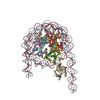
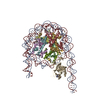

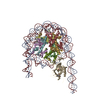

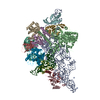


 Z (Sec.)
Z (Sec.) Y (Row.)
Y (Row.) X (Col.)
X (Col.)





















